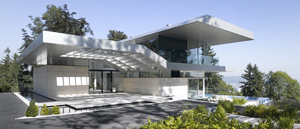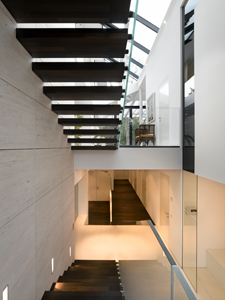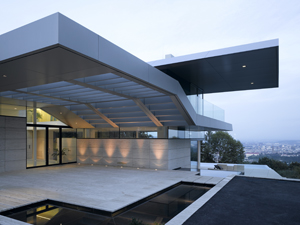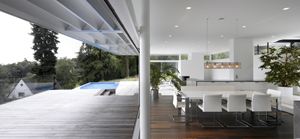 |
 |
 |
 |
 |
 |
| |
 |
|
 |
 |
 |
  |
  |
 |
 |
 |
 |
|
|
 |
|
 |
 |
 |
BUILDING |
 |
|
 |
|
 |
 |
 |
| |
 |
| 
 |
Villa A
|
|
 |
 |
 |
 |
DESIGNER |
 |
|
|
 |
|
 |
 |
 |
| |
 |
|
 |
 |
 |
 |
DESCRIPTION |
 |
|
|
 |
|
 |
 |
 |
|
|
 |
 A young entrepreneur bought a beautiful piece of land on the slope of the Poestling Berg, a mountain overlooking Linz the capital of Upper Austria. In 2007 he commissioned the architects to design a house for him and his family. He desired architecture of openness embedded in the green slope above the city. A young entrepreneur bought a beautiful piece of land on the slope of the Poestling Berg, a mountain overlooking Linz the capital of Upper Austria. In 2007 he commissioned the architects to design a house for him and his family. He desired architecture of openness embedded in the green slope above the city.
He requested 650m2 for all living and sleeping including garage.
The property is about 5000m2 in a protected green zone with an old tree population. On the more slanted east side there is a small fir forest, whereas scattered broad leaf trees cover the widows of the western slope. This led the architects to orient the living areas towards south west. This side is entirely open to the panoramic view over the city and the garden.
On the north side the building facade is closed with natural stonework to provide intimacy towards the street.
The site is accessed from the road behind leading down hills to the lands main entrance gate. The small road then takes you down to the main entrance bounded by a 2m wide moat / pond and huge cantilevering roof (7 by 10 meters). Continuing, the slanted road takes you to the lower level, leading to the garage and the second entrance on the east side of the building.
 Following the topography of the site the house is partly caved in the ground. A central hall with an open stair gives access to various areas on different levels. Following the topography of the site the house is partly caved in the ground. A central hall with an open stair gives access to various areas on different levels.
Garage, building services, fitness area, guest room and office are allocated in the lower, carved in story. Living, dining and kitchen area are distributed on three different levels on the middle part of the building. The sleeping rooms are situated in the roof structure on the upper level.
The architect’s intension was to differentiate formally and structurally the upper floor from the other two levels below. The purpose was to contrast the different function in the building. The lower levels are mostly designated for living, lounging and dining. These activities are embedded with different levels into the topography of the land and have direct access to the surrounding garden. The earthy relationship led the architects to opt for massive concrete structure that is gladded with stone.
Above these, bedrooms are embedded into roof structure is carried by steel columns, totally detached from the massive walls below, almost flying over the massive walls.
Throughout the design the architect’s intended to experience the building as object that is experienced gradually in sequences. This led to a specific design methodology where certain view and situation are observed. Then spatial visions where rendered in sequences. The passage around and through the building was set up similar to a story board use for movie making. From there the architects glued these clips to set the spatial visions to a building configuration. |
|
 |
 |
 |
|
 |
|
| Entrances and Central Hall |
 |
|
 |
 One approaches the building crossing the small pond one is invited to take a breathtaking panorama view of the city before entering the central hall of the house. This area is covered with a huge cantilevering roof. One approaches the building crossing the small pond one is invited to take a breathtaking panorama view of the city before entering the central hall of the house. This area is covered with a huge cantilevering roof.
The stone gladded wall (travertine stone from Italy) penetrates the glass façade leading to the inside. The same floor materials (Italian limestone) are applied out- and indoors enhancing the flow of from and materials from outside to inside.
This architectural language embeds the building into the landscape, transforming it to an integrative part of it.
Various functions and levels are accessed from a central hall that runs through the entire building connecting the both entrances on the west and east side. The hall allocates an open stair with cantilevering steps, leading to the gallery upstairs or the areas downstairs.
The large glazing of the roof and entrances illuminates the entire hall. |
|
 |
 |
 |
|
 |
|
| Dining, Kitchen and Living area |
 |
|
 |
 Kitchen, Dining and Living are all gathered in one open space. Kitchen, Dining and Living are all gathered in one open space.
From the central hall the dining area with an open kitchen is reached by taking a few steps down. The floor is covered with steamed acacia parquet expanding to the outdoor terrace. The customized kitchens with its cooking island in the middle allocate a small bar for snacks and drinks. All working surfaces and the bar are covered with dark marble from Italy.
From the dining area another couple of steps lead to a comfortable area where one can lounge on the sofa or chaise longue overlooking the swimming pool and enjoying the marvelous view over the city. There the floor is covered with a bright limestone, similar to the outdoor flooring at the pool level.
The client asked for an additional more itemed closed salon which at the level of the entrance. There the walls are gladded with leather panels.
The architect’s intention was to embrace different functions in one open living area, accommodating the various functions on different levels, always balancing their functional particularities within an open space. The floor materials are distinguished according to level and function.
Moreover the large scale glazing and the sliding elements blurs the indoor area and outdoor space. |
|
 |
 |
 |
|
 |
|
| Bedrooms and Bathrooms |
 |
|
 |
| The three bedrooms with bathrooms are located on the upper levels that are accessed by stairs which lead to the open gallery. |
|
 |
 |
 |
|
 |
|
| Basement |
 |
|
 |
| The basement floor is partly carved in the ground allocates fitness and wellness facilities, office and a playroom for children. The parking garage and the machine room are dug in under the access road on the north side of the building. |
|
 |
 |
 |
 |
 |
 |
 |
ECO-SUSTAINABILITY |
 |
|
|
 |
|
 |
 |
 |
|
|
 |
The Roof is a steel beam grid structure with aluminium panel cladding. On the southern and western side of the building the roof cantilevers beyond the terraces so as to provide an efficient sun protection in summer. The low winter sun warms up the interior space. This implementation of the passive energy concept is supported by a recuperator in the ground and sun collectors on the roof.
It is highly energy efficient and fulfils all requirements for a “green building”, as set in the European building standards. |
|
 |
 |
 |
 |
 |
 |
 |
LOCATION |
 |
|
|
 |
|
 |
 |
 |

|
 |

|
Continent |
|
 |
|
Nation |
|
 |
|
State |
|
 |
|
Metropolitan borough |
|
 |
|
Town |
|
 |
|
District |
|
 |
|
Address |
|
 |
|
|
|
 |
|
 |
 |
 |
 |
MAP |
 |
|
|
 |
|
 |
 |
 |
| |
 |
|
 |
 |
 |
 |
|
TYPOLOGY |
 |
|
|
 |
|
 |
 |
 |
Main |
 |
|
 |
ARCHITECTURE | Residential buildings
Detached, semi-detached houses and villas
| |
|
|
 |
|
Additional |
 |
|
 |
LANDSCAPE ARCHITECTURE AND NATURAL ENVIRONMENTS | Landscape architecture
Private gardens
| |
 |
 |
 |
 |
CHRONOLOGY |
 |
|
|
 |
|
 |
 |
 |
Project |
 |
|
 |
| 
 |
2007
|
|
Realisation |
 |
|
 |
| 
 |
2008 - 2009 |
|
 |
 |
 |
 |
CLIENT |
 |
|
|
 |
|
 |
 |
 |
| |
 |
|
 |
 |
 |
 |
DIMENSIONAL
DATA |
 |
|
|
 |
|
 |
 |
 |
| Surface |
 |
|
 |
|
 |
 |
 |
 |
STRUCTURES |
 |
|
|
 |
|
 |
 |
 |
| |
 |
|
 |
 |
 |
 |
STAFF |
 |
|
|
 |
|
 |
 |
 |
|
 |
|
Design team |
 |
| Julia Martin, Ali Reza Milaninia, Sebastian Brandter |
|
Landscape design |
 |
| topolis landscape architecture (garden design) |
|
Systems |
 |
|
Computerization |
 |
| Patrias Ing. Rudolf Patrias |
|
General contractor |
 |
|
 |
 |
 |
 |
CREDITS |
 |
|
|
 |
|
 |
 |
 |
| |
 |
Photos © Manfred Seidl
Drawings © Najjar&Najjar Architekten
Text edited by Najjar&Najjar Architekten
Courtesy of Najjar&Najjar Architekten
|
|
 |
  |
 |
|
|